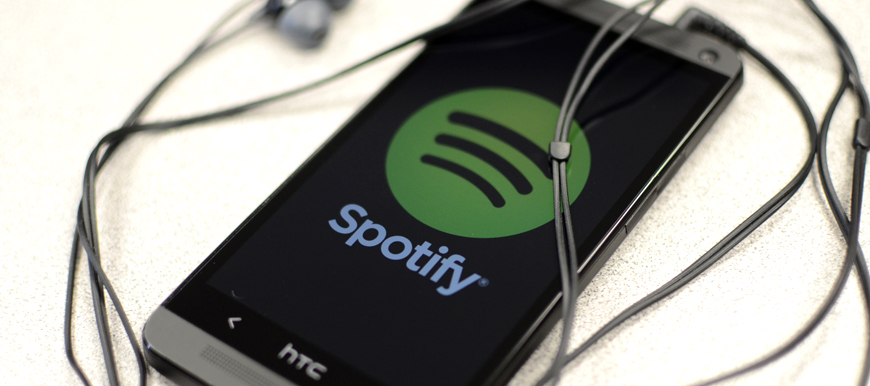To stream or not to stream
After Taylor Swift decided to pull her entire catalog from the popular music streaming service earlier in November, founder and CEO of Spotify Daniel Ek faces a dilemma: $2 billion in royalties paid by Spotify or nothing paid through piracy.
In a blog post on the Spotify website on Nov. 11 titled “$2 Billion and Counting,” Ek wrote about myths surrounding Spotify that frustrate him, specifically, about how his company goes about paying artists featured on the site.
In the post he spells out three myths: that free music on Spotify for fans means artists don’t get paid, that Spotify pays so little per play that no one could earn a living from it and that the service hurts sales of the music in all forms.
Ek explained how Spotify’s “freemium” model, supported by ads, makes the service competitive with free services, such as YouTube and SoundCloud; the “pay for every play” concept allows Spotify to pay royalties for 500,000 plays from 500,000 listeners rather than for one play on a radio listened to by 500,000 listeners. Lastly he explains how many popular artists promoted their new releases on Spotify and saw record sales in physical albums and downloads.
Those defenses have not come without criticism. Thom Yorke, lead vocalist for the band Radiohead, has clashed with Spotify via social media and explained why he feels that such music-streaming services are another way for major music producers to ride the success of their artists and consequently leave new and rising musicians on the outside peering in.
In an interview in October of 2013 with the Mexican website Sopitas, Yorke went as far as to call the service, “the last desperate fart of a dying corpse,” referring to the companies close ties with major labels and producers.
In 2007 Yorke and fellow Radiohead bandmates released their album “In Rainbows” on their website free to download for the price the listener wished to pay for it. During the 2013 interview with Sopitas, Yorke compared the self release with the “freemium” model of Spotify.
“When we did the ‘In Rainbows’ thing, what was most exciting was the idea you could have a direct connection between you as a musician and your audience,” he said. “You cut all of it out, it’s just that and that. And then all these f***ers get in a way, like Spotify suddenly trying to become the gatekeepers to the whole process.”
In Yorke’s most public criticism of the service, he explains that in the Spotify business model artists themselves fall heavily in priority with shareholders and employees to pay first. The remaining monetary resources are lost in fees from the artist’s label company before the artists sees any profit, an attack Daniel Ek countered in his November 11 article posted to the Spotify website.
“We’ve already paid more than $2 billion in royalties to the music industry and if that money is not flowing to the creative community in a timely and transparent way, that’s a big problem,” Ek wrote. “We will do anything we can to work with the industry to increase transparency.”
Two local musicians and Utah State University students lean strongly in favor of Thom Yorke’s assessment of Spotify, that it isn’t able to properly pay popular and new, independent artists.
Nate Dukatz, drummer for two local bands, Bronze Museum and Kitfox, felt as if Radiohead and Taylor Swift were smart in pulling their catalogs from the service.
“(Thom Yorke) can sell albums without Spotify,” Dukatz said, “just like how Taylor Swift can. If people can’t find their music on Spotify they’ll go and buy the physical album or download it. If I were him, I wouldn’t put my music up there.”
Dukatz explained that he and his bands use the service more for exposure rather than being paid for their music.
“Saying that we’re on Spotify is something we avoid on stage because it hurts album sales,” he said. “In a lot of people’s minds you have to be a quality artist to be featured on Spotify, which isn’t true, but it’s something we use to seem more legitimate.”
Emilee Holgate, lead vocalist and guitarist for Kitfox, agreed due to personal experience, having had an album on a myriad of music services including Spotify.
“At least at the local level I’ve seen having our EP up on Spotify for over a year bring in about 98 cents in royalties,”Holgate said.
Holgate agreed with Dukatz that Spotify is much more convenient for exposure at the local level. In regards to Spotify being a good way to reach new listeners, Holgate said the response is good and bad.
“Since we have an EP up there (on Spotify) people will come to our show and then listen to our album,” she said. “The bad part is that if they’re listening to our album there, then they won’t be willing to actually buy it at the show.”
Both musicians said they prefer other services as artists and listeners, such SoundCloud and Bandcamp, which cut out the third party and eliminate the fee required by Spotify and iTunes to upload tracks.
Holgate and Dukatz felt as if Bandcamp was the service most friendly to artists due to the site’s ability to link to personal PayPal accounts and the attention the site commits to building a community for new artist exposure.
While CEOs like Daniel Ek and world-famous rockstars of Thom Yorke’s or Taylor Swift’s caliber may have different views on the best way to share and listen to the music you love, Holgate had some advice to share with the crowds who enjoy the music around Cache Valley.
“Come to our shows, and buy the album,” she said. “If you hear about us, then listen online, but if you come to (our) show, the best way to support us is to buy the album.”
— news.ar@usu.edu

